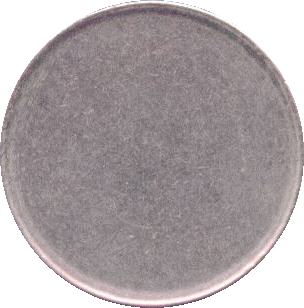
FULL VIEW OF A MAGNIMAT
EXPERIMENTAL PLANCHET
![]()
EDGE VIEW OF A MAGNIMAT
EXPERIMENTAL PLANCHET
Magnimat Experimental Planchet |
|
This is one of the actual Magnimat planchets that was handed out to the Subcommittee on Historic Preservation & Coinage hearings held by the U.S. House of Representatives on May 31, 1978. Mr. Horst L. Rinke, a representative of the VDM Company of West Germany, presented them to the subcommittee for their consideration as the planchet to use for the small size dollar. Quoting from Mr. Rinke's testimony, "Magnimat is a composite or sandwich metal that does not look like a sandwich material because its layers consist of nickel and cupronickel and do not differ in color." |
These pieces entered the numismatic market when
subcommittee staff director, Jackson O'Neill Lamb, having
gathered the samples together after the hearings, sold them to a
Virginia coin dealer. Mr. Lamb is a nephew of Thomas
"Tip" O'Neill, who was then Speaker of the House of
Representatives. Magnimat is desirable for coinage due to its
unique physical and magnetic properties which give it optimum
security against fraud in coin-operated machines. It has been
used in high denomination coinage in several European nations.
The Magnimat was probably rejected for two reasons. One, it is an
expensive material to produce, and two, the VDM Company owned an
international patent on it and the US Mint was not likely to use
a planchet that they didn't have control of. There are 18
Magnimat planchets known, all come with INS authentication
papers.
|
|
International Numismatic Society Authentication Bureau certificate that originally accompanied all 18 Magnimat planchets. |